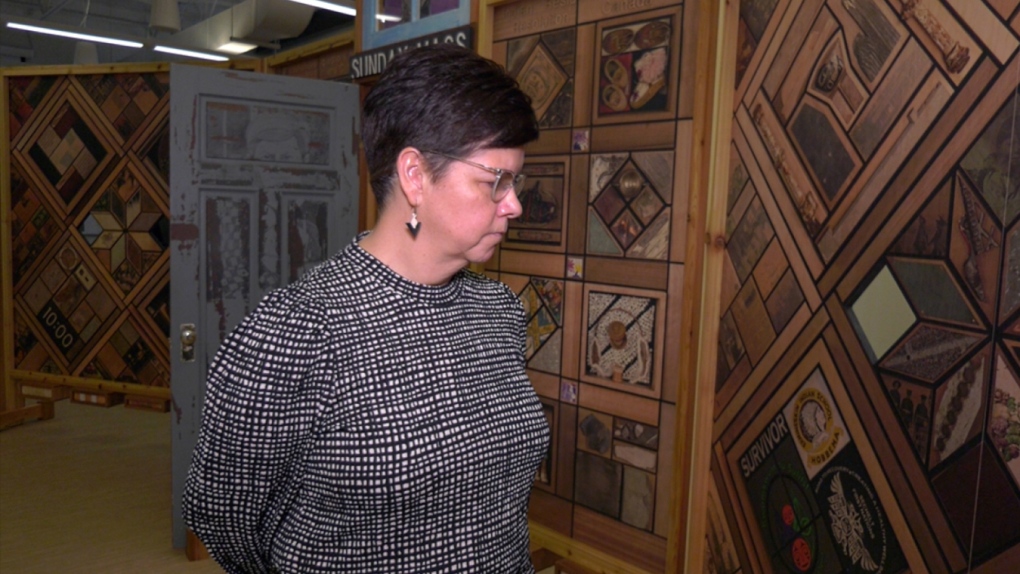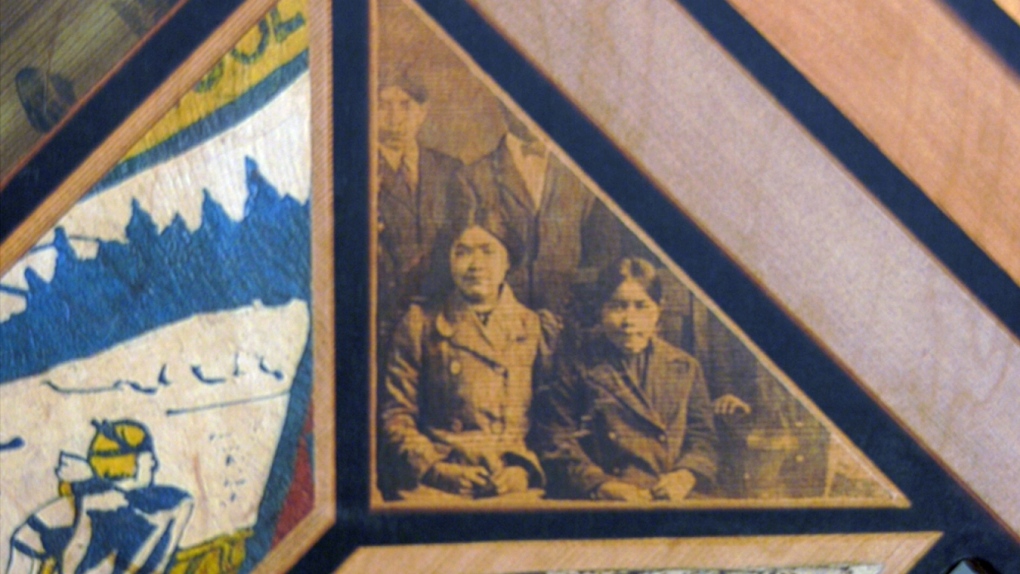Thought-provoking residential school exhibit on display at Canadore College
For the next few weeks, The Village at Canadore College will be the home of a thought-provoking museum exhibit that tells the story of Canada’s troubled history with residential schools.
The exhibit is called ‘The Witness Blanket.’
 Nipissing University’s Chair of Indigenous Education Cindy Peltier took CTV News on a walk through 'The Witness Blanket' exhibit. (Eric Taschner/CTV News Northern Ontario)As Nipissing University’s Chair of Indigenous Education Cindy Peltier took a walk through the exhibit, she felt the strength and resilience. Her two grandmothers are residential school survivors. They attended an institution in Spanish, Ont.
Nipissing University’s Chair of Indigenous Education Cindy Peltier took CTV News on a walk through 'The Witness Blanket' exhibit. (Eric Taschner/CTV News Northern Ontario)As Nipissing University’s Chair of Indigenous Education Cindy Peltier took a walk through the exhibit, she felt the strength and resilience. Her two grandmothers are residential school survivors. They attended an institution in Spanish, Ont.
“The Witness Blanket is a time to think about those brave souls,” she said.
Nipissing University and Canadore College collaborated to bring the exhibit to North Bay.
“I want people to come and reflect to walk through this exhibit, understand and gain some knowledge about residential schools,” said Canadore College First Peoples’ Centre Interim Director Sarah Julian.
The exhibit
‘The Witness Blanket’ was created by multi-disciplinary Indigenous artist, master carver, filmmaker, author and public speaker Carey Newman. Inspired by a woven blanket, it’s a 12-metre-long work of art that contains over 850 reclaimed items from residential schools, churches, and government buildings across 77 Canadian communities.
 The Village at Canadore College will be the home of a thought-provoking museum exhibit that tells the story of Canada’s troubled history with residential schools called ‘The Witness Blanket' for the next few weeks. (Eric Taschner/CTV News Northern Ontario)Each image or artifact represents a life lived at these institutions.
The Village at Canadore College will be the home of a thought-provoking museum exhibit that tells the story of Canada’s troubled history with residential schools called ‘The Witness Blanket' for the next few weeks. (Eric Taschner/CTV News Northern Ontario)Each image or artifact represents a life lived at these institutions.
“It’s more than an exhibit piece. They represent stories,” said Peltier.
“For me and other Indigenous peoples, I think this is going to be very personal.”
In total, an estimated 150,000 Indigenous children were forced to attend the more than 130 Indian residential schools operated across Canada. First Nations cultures, traditions and languages were eroded through this forced assimilation. It was part of a broader process of colonization and genocide. The residential school system was a deliberate attempt to destroy First Nations, Inuit and Métis communities and ways of life.
“The last residential school closed in 1996,” said Julian.
“So it wasn’t really that long ago and you know people, the family: your cousins, brothers and sisters. It’s not something that was thousands of years ago.”
The exhibit at The Village is one of two reproductions made for travel so the stories could be shared with Canadians from coast to coast to coast. The original Witness Blanket is currently housed at the Canadian Museum for Human Rights awaiting installation in its core galleries. In these wood‐framed reproductions, direct‐printed wood panels take the place of the original artifacts and interior frames.
“It’s an opportunity to learn and understand what truth and reconciliation means,” said Julian.
The exhibit is on display Monday to Friday from 10 a.m. to 3 p.m. until Feb. 16.
If you are a former residential school student in distress, or have been affected by the residential school system and need help, you can contact the 24-hour Indian Residential School Crisis Line: 1-866-925-4419. Additional mental-health support and resources for Indigenous Peoples are available from 'Hope for Wellness.'
CTVNews.ca Top Stories

DEVELOPING Driver rams New Year's revellers in New Orleans, killing 10. FBI investigating as 'act of terrorism'
A driver wrought carnage on New Orleans' famed French Quarter early on New Year's Day, killing 10 people as he rammed a pickup truck into a crowd before being shot to death by police, authorities said.
Missing hiker with arrest warrant found after friends delay police report: B.C. RCMP
Mounties in British Columbia are warning the public to be honest after a missing hiker's friends delayed reporting her disappearance to police.
Manhunt underway in Sask. after inmate escapes federal prison
Police are seeking the public's assistance in locating an inmate who escaped from the Saskatchewan Penitentiary in Prince Albert.
FBI finds 150 homemade bombs at Virginia home in one of the largest such seizures, prosecutors say
Federal agents found one of the largest stockpiles of homemade explosives they have ever seized when they arrested a Virginia man on a firearms charge last month, according to a court filing by federal prosecutors.
Here are some of the new laws and rules coming into effect in Canada in 2025
From boosting child and disability benefits to increasing protections for workers, here’s a look at new measures coming into effect in 2025.
What we know about a vehicle attack on pedestrians in New Orleans' French Quarter that killed several
Authorities say the driver of a pickup truck sped through a crowd of pedestrians gathered in New Orleans' bustling French Quarter district early on New Year's Day, killing several people. Here's what we know about the attack.
Financial changes in Canada you should know about this year
There are a few changes in federal policies that could affect Canadians' finances in the new year.
Ford, Acura, Land Rover recall vehicles over safety risks
Certain Ford, Acura and Land Rover models have been recalled in Canada over a variety of issues that pose a risk to drivers’ safety.
With calls for Trudeau's resignation, Poilievre's Conservatives hold 26-point advantage over Liberals: Nanos
Pierre Poilievre's Conservatives are closing out 2024 hitting a new long-term high in ballot support, with a 26 point advantage over the Liberals amid calls for Prime Minister Justin Trudeau to resign.
































